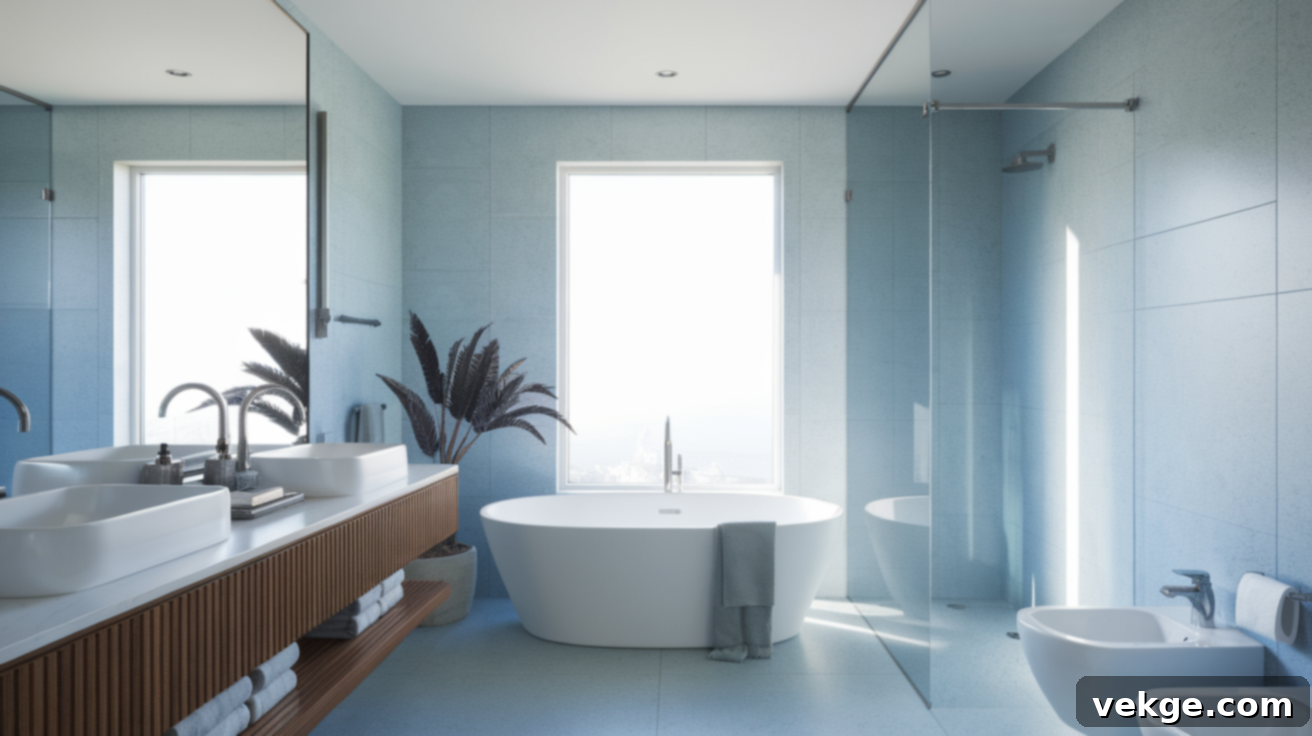Mastering Monochromatic Bathroom Design: A Comprehensive Guide to Stylish Single-Color Sanctuaries
Are you envisioning a bathroom that exudes both sophistication and serenity? A monochromatic design might be the ultimate solution for transforming your space into a peaceful retreat. This elegant approach involves utilizing a single dominant color throughout your bathroom, artfully integrating different shades, tones, and textures. The result is a visually captivating environment that feels inherently cohesive, neither busy nor overwhelming, yet rich in subtle detail.
Whether you’re captivated by the crisp, luminous quality of white, the understated modern sophistication of gray, or the bold, dramatic impact of black, monochromatic bathrooms offer limitless possibilities for personal expression. This design philosophy not only delivers a stunning aesthetic but also brings practical benefits. It can ingeniously make smaller bathrooms feel more expansive, cultivate a profound sense of calm, and ensure your design remains timeless, gracefully standing the test of fluctuating trends.
Join us as we delve into the art of creating your perfect single-color sanctuary, exploring the principles, practical steps, and inspiring ideas that will elevate your bathroom to a new level of design excellence.
What Exactly is a Monochromatic Bathroom?
At its core, a monochromatic bathroom embraces a singular color as its foundation, weaving various shades, tones, and tints of that chosen hue throughout the entire space. This design philosophy hinges on creating a unified and harmonious look while simultaneously generating visual interest through the subtle interplay of light and dark within the same color family. The inherent beauty of a monochromatic bathroom lies in its elegant simplicity and the sophisticated depth it achieves.
By committing to one primary color—be it the pristine purity of white, the grounding essence of gray, the tranquil depths of blue, the natural vitality of green, or the striking drama of black—you meticulously craft a space that feels impeccably cohesive and thoughtfully planned. This focused approach offers a multitude of advantages. Firstly, it fosters a profound sense of calm and order, effectively transforming your bathroom into a private, peaceful haven from the outside world.
Furthermore, the single-color design inherently minimizes visual clutter. This can be particularly advantageous in compact bathrooms, as the absence of stark color contrasts allows the eye to flow uninterruptedly around the room, making the space feel perceptibly larger and more open. Beyond its functional benefits, this style possesses an enduring appeal, often transcending fleeting trends to remain classically elegant.
The secret to preventing a monochromatic scheme from appearing flat or monotonous lies in the thoughtful incorporation of diverse textures. Imagine the interplay of glossy ceramic tiles reflecting light against the soft, matte finish of painted walls, or the cool, smooth touch of polished marble juxtaposed with the warmth of a textured woven rug. These contrasting textures provide tactile and visual variety, enriching the single-color palette without introducing additional hues. The ultimate outcome is a bathroom that masterfully blends simplicity with intriguing depth and character.
Choosing the Right Color for Your Monochromatic Bathroom
The selection of your core color is arguably the most critical decision and the very foundation upon which a successful monochromatic bathroom is built. Your chosen hue will dictate the mood, ambiance, and overall character of the entire space. Taking the time to thoughtfully consider which color best aligns with your practical needs, personal aesthetic, and desired atmosphere is an investment that will undoubtedly pay dividends.
| Color | Feel and Style | Best For |
|---|---|---|
| White | Clean, fresh, expansive, timeless, minimalist | Small bathrooms, spaces with limited natural light, creating a bright and airy feel, modern and traditional aesthetics. |
| Gray | Modern, sophisticated, calm, versatile, neat, industrial | Hiding dirt and water spots, creating a contemporary look, complementing most fixtures and finishes, adding a grounding presence. |
| Blue | Peaceful, serene, calm, clean, refreshing, spa-like | Relaxation spaces, creating a tranquil retreat, often paired beautifully with white or chrome fixtures, coastal or nautical themes. |
| Green | Natural, earthy, calming, vibrant, restorative, living | Connecting to the outdoors, spaces with plants, bathrooms incorporating wood or stone elements, promoting a sense of well-being. |
| Black | Bold, striking, dramatic, luxurious, strong, mysterious | Making a powerful statement, spaces with good lighting (natural or artificial), bathrooms with high-shine tiles and mirrors for reflection, creating a boutique hotel vibe. |
How to Select the Best Monochromatic Color for Your Space
When embarking on the crucial task of choosing your monochromatic color, consider these important factors to ensure your selection is both beautiful and functional:
- Bathroom Size & Perception: This is a fundamental consideration. Lighter colors possess an inherent ability to make small bathrooms feel considerably larger and more open by reflecting light and minimizing visual boundaries. Conversely, darker shades can create a sense of intimacy and coziness, which can be highly desirable in more expansive bathrooms. If your bathroom is compact, prioritize white, light gray, or pale blue tones to maximize the feeling of spaciousness.
- Natural Light Availability: The amount of natural light your bathroom receives will significantly influence how your chosen color appears. Bathrooms blessed with abundant windows and sunlight can comfortably accommodate deeper, darker color schemes without feeling dim or claustrophic. However, if your bathroom has limited natural light, opting for lighter colors is essential. These hues will help to brighten and uplift the space, preventing it from feeling enclosed or unwelcoming.
- Your Daily Routine & Desired Mood: Reflect on how you primarily use your bathroom. Is it predominantly for quick, energizing morning routines? If so, brighter, more stimulating colors like crisp white or invigorating light blue can contribute to a wakeful and fresh start to your day. Conversely, if your bathroom is envisioned as a sanctuary for long, relaxing evening baths, deeper, more saturated tones like a calming navy or a rich forest green might be more conducive to creating a soothing and tranquil atmosphere.
- Cohesion with Your Home’s Overall Style: Your bathroom should not exist in isolation. For a truly harmonious living environment, select a color palette that complements and feels connected to the adjacent rooms and your home’s overarching design aesthetic. This thoughtful consideration helps to create a seamless visual flow and a unified design narrative throughout your entire residence.
- Test Before Committing: This step is non-negotiable. Before making any final decisions or purchasing large quantities of paint or tiles, invest in samples of your chosen color. Apply these samples to various spots throughout your bathroom and observe them at different times of the day. Notice how the color shifts and appears under varying natural and artificial light conditions. This crucial step prevents costly mistakes and ensures you’ll love the final outcome.
How to Create a Monochromatic Bathroom Design: Step-by-Step
Crafting a truly stunning monochromatic bathroom involves much more than simply selecting a single color and applying it uniformly. It’s a sophisticated art of meticulously building layers of the same hue, strategically introducing variations in shade and texture to create a space that boasts remarkable depth, visual interest, and a luxurious feel.
Here’s a structured approach to master this elegant design style:
Choosing the Base Color
Begin by solidifying your primary color choice, as this will serve as the foundational bedrock of your entire bathroom design. As discussed, this pivotal decision should deeply resonate with your personal style, intelligently consider the specific size and natural lighting conditions of your bathroom, and, most importantly, be a color that you genuinely adore and will enjoy living with day in and day out. Once this overarching base color is established, select a specific shade within that color family to act as your primary tone. This shade will dominate the largest surfaces within your bathroom, such as the walls and significant fixtures, setting the stage for the rest of your design.
Layering Different Shades and Tints
The true genius and defining characteristic of a successful monochromatic bathroom lie in the masterful manipulation of various shades, tones, and tints of your chosen color. This layering technique is what prevents the space from feeling flat and infuses it with dynamic depth:
- Grounding Elements: Reserve the darkest shades of your chosen color for elements that provide visual weight and grounding. This often includes floor tiles, lower cabinetry, or the base of a freestanding tub. These deeper tones anchor the room and create a sense of stability.
- Primary Surfaces: Apply medium tones to expansive surfaces like your walls, shower surrounds, or larger vanity units. These shades form the main body of your color scheme and bridge the gap between the darkest and lightest elements.
- Illuminating Accents: Utilize the lightest shades for areas you wish to highlight or expand, such as ceilings, window trims, and smaller decorative accents. These lighter hues reflect the most light, contributing to an airy and open feel.
- Balanced Proportions: Aim for a balanced distribution of these tones. A common design principle suggests roughly 60% of your space should be the primary (medium) shade, 30% a secondary (darker or lighter) shade, and 10% an accent (darkest or lightest) shade. This provides a harmonious yet dynamic visual rhythm.
- Minimum Tonal Variation: To ensure adequate depth and to avoid a one-dimensional appearance, strive to incorporate at least three distinct tones or shades of your chosen color. This creates enough visual texture and movement for the eye to appreciate.
For a practical illustration, imagine a serene blue bathroom: you might opt for a sophisticated navy blue on the floor tiles to ground the space, transition to a calming medium blue for the main wall surfaces, and then introduce a delicate pale sky blue for the ceiling or specific decorative elements like towels or a small vase.
Incorporating Texture: The Key to Depth
Texture is the unsung hero of monochromatic design, serving as the essential element that prevents a single-color bathroom from appearing bland, flat, or uninspired. Without varied textures, even the most beautiful color scheme can fall short. The goal is to create a rich tactile experience that engages the senses and adds visual complexity without introducing additional colors.
Strategically mix and match diverse materials to achieve this. Consider the striking contrast between sleek, glossy subway tiles that beautifully reflect light and a subtly textured, matte-painted wall that absorbs it. Imagine the luxurious feel of smooth, cool marble countertops juxtaposed with the subtle grip and natural imperfections of textured stone shower floors. Each material brings its own unique character and plays a vital role in building depth.
Don’t overlook the importance of fabric elements. Plush, absorbent cotton towels in varying weaves, a soft chenille bath mat, or a subtly patterned woven curtain can introduce warmth, comfort, and another layer of visual interest. Hardware finishes also present an opportunity for textural contrast; consider brushed metals (like nickel or brass) for a softer gleam, or polished chrome for a high-shine, reflective quality. Finally, the strategic use of reflective surfaces such as large glass shower doors, polished mirrors, or even mirrored cabinet fronts can bounce light around the room, adding an extra dimension and further enhancing the perceived depth of the space.
The intentional contrast between smooth and textured, shiny and matte surfaces creates a sophisticated interplay that adds profound depth without ever breaking from your carefully chosen color scheme. This nuanced approach ensures that your eyes have different elements to discover and appreciate, effectively transforming a single-color bathroom into a captivating and anything-but-monotonous environment.
Monochromatic Bathroom Ideas to Inspire Your Design
Are you seeking the perfect monochromatic bathroom style that speaks to your aesthetic? Here are thirteen inspiring examples, each meticulously demonstrating how a single color, thoughtfully employed across a spectrum of shades and textures, can cultivate a bathroom rich in personality, elegance, and distinct style. From the airy brightness of white to the profound drama of black, these ideas powerfully illustrate the transformative potential of a focused color palette.
1. White Monochromatic Bathroom: The Classic Canvas
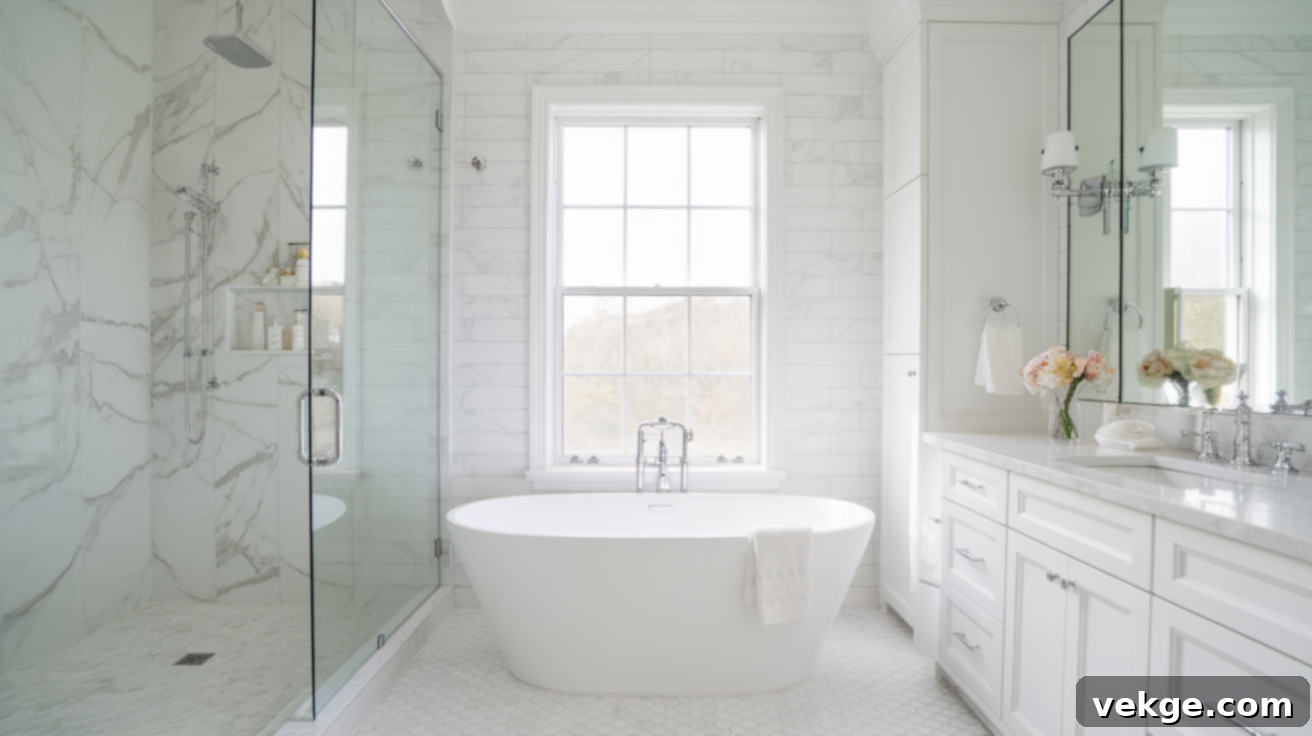
A white monochromatic bathroom offers the ultimate clean canvas, instantly creating a space that feels open, bright, and utterly pristine. To avoid a sterile look, layer various warm and cool whites: mix crisp, brilliant white walls with the inviting softness of ivory or pearl-toned tiles. Introduce cream-colored plush textiles, like luxurious towels or a bath mat, for added warmth and texture. White marble countertops, with their delicate grey or gold veining, subtly introduce pattern and a touch of understated luxury without deviating from the color scheme. Complete this ethereal look with chrome or brushed nickel fixtures, chosen for their ability to reflect light beautifully and enhance the overall brightness of the space.
2. Gray Monochromatic Bathroom: Modern Sophistication

Gray offers a pathway to a modern, incredibly versatile, and timeless bathroom aesthetic that seamlessly integrates into homes of any style. Create depth by combining light pearl gray walls with medium slate gray floor tiles. Introduce darker charcoal gray accents through accessories, perhaps a sleek vanity or striking hardware. The clever mix of high-gloss shower tiles reflecting light against the soft, matte finish of cabinetry or painted walls adds crucial textural contrast and visual intrigue. Chrome or brushed steel fixtures provide subtle yet sophisticated metallic accents. This sophisticated color scheme is also remarkably practical, adeptly hiding water spots and daily grime better than pure white, all while maintaining an impeccably clean and polished appearance.
3. Blue Monochromatic Bathroom: Tranquil Escape
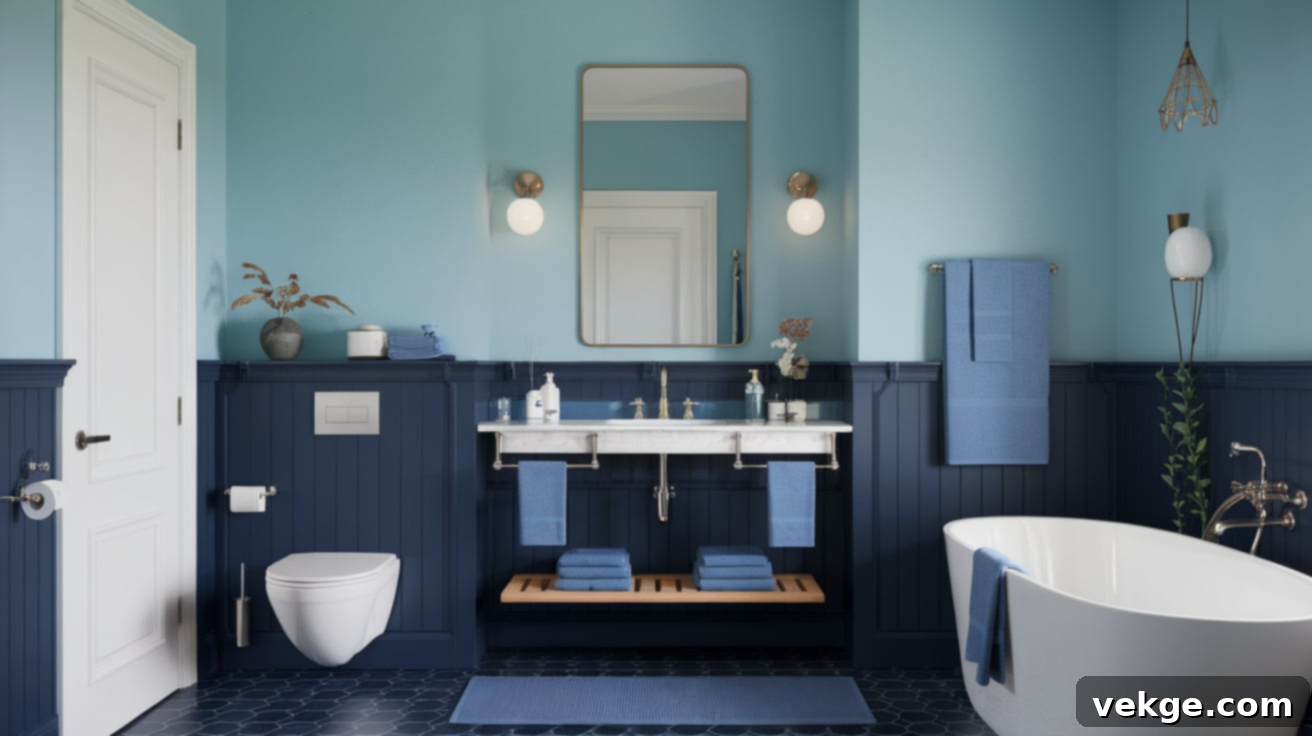
Blue bathrooms inherently possess a profoundly calming, fresh, and invigorating feel, reminiscent of serene waters. Achieve a perfectly balanced look by pairing soft sky blue walls that evoke an open atmosphere with deeper navy or marine blue floor tiles to anchor the space. Use marine blue towels, bath mats, and accessories to seamlessly bridge the tonal gap between the lighter and darker shades. For a subtle yet impactful continuation of the theme, consider incorporating a blue-tinted mirror or opting for elegant glass shower doors with a slight blue hue. This naturally refreshing color palette pairs exceptionally well with classic white fixtures, effortlessly cultivating a luxurious, spa-like retreat within your home.
4. Green Monochromatic Bathroom: Nature’s Embrace

A green monochromatic bathroom design brilliantly connects your indoor space to the tranquility of nature, forging a peaceful and rejuvenating retreat. Establish your base with soothing sage green walls, perhaps using a matte paint finish. Introduce richer forest green accent tiles, perhaps in a subtle geometric pattern, and complement with olive or moss-toned towels and accessories. Integrate natural stone textures in green-gray tones—such as a slate vanity top or pebble shower floor—to amplify the earthy, organic feel. This verdant color palette harmonizes beautifully with natural wooden accents, like a teak stool or a bamboo mirror frame, and is perfectly enhanced by live plants, making it an ideal choice for bathrooms abundant in natural light.
5. Black Monochromatic Bathroom: Bold Drama
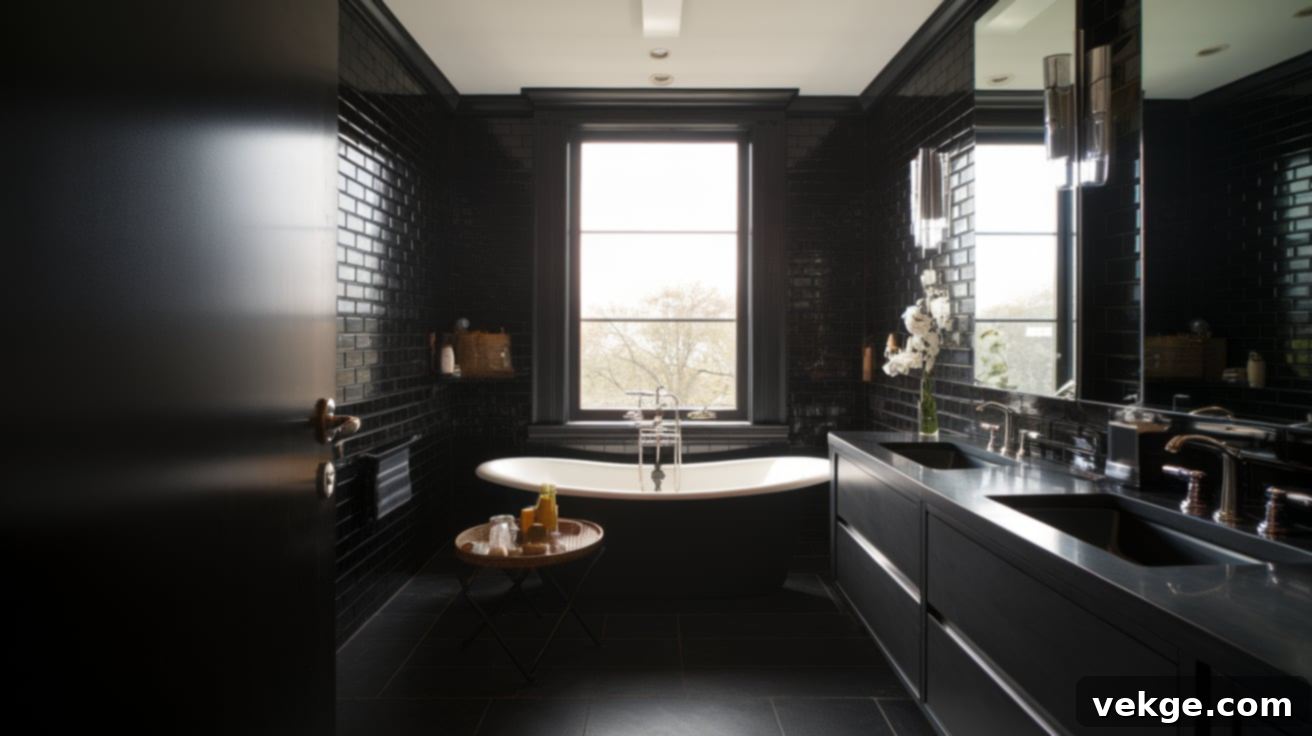
Black monochromatic bathrooms deliver a powerful and undeniable statement, characterized by their strong, dramatic, and luxurious aesthetic. To prevent the space from feeling oppressive, master the interplay of texture: combine high-shine black tiles that reflect light brilliantly with velvety matte black paint on walls or sleek matte black fixtures and cabinetry. This textural contrast is paramount. Crucially, include ample mirrors and strategically placed metallic accents (such as brass or copper) to effectively bounce light around the space, alleviating any potential darkness and adding a touch of glamour. This bold color choice truly thrives in bathrooms equipped with excellent natural or artificial lighting, ensuring the space feels sophisticated rather than somber.
6. Small White Monochromatic Bathroom: Maximizing Space
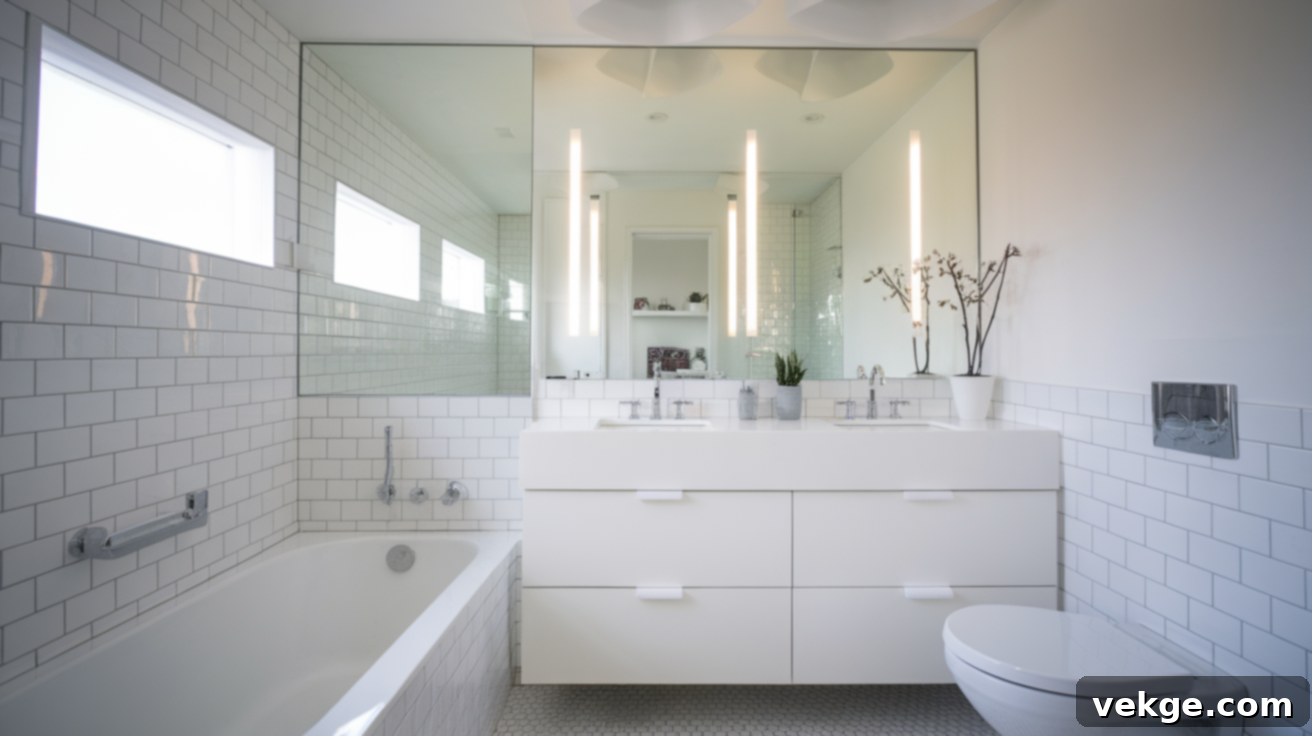
Small bathrooms are ideal candidates for the inherent space-expanding qualities of white. To achieve maximum openness, utilize bright, crisp whites on walls and ceilings, perhaps with a subtle difference in tone for tiles and fixtures, leaning slightly towards warmer whites or off-whites. Prioritize minimal, wall-mounted storage solutions to maintain an uncluttered and expansive feel. The strategic placement of large, frameless mirrors and transparent glass shower doors is key; these elements are not just functional but also instrumental in reflecting light and creating an illusion of depth, making the bathroom feel significantly larger and airier than its actual dimensions.
7. Contemporary Gray Monochromatic Bathroom: Urban Edge
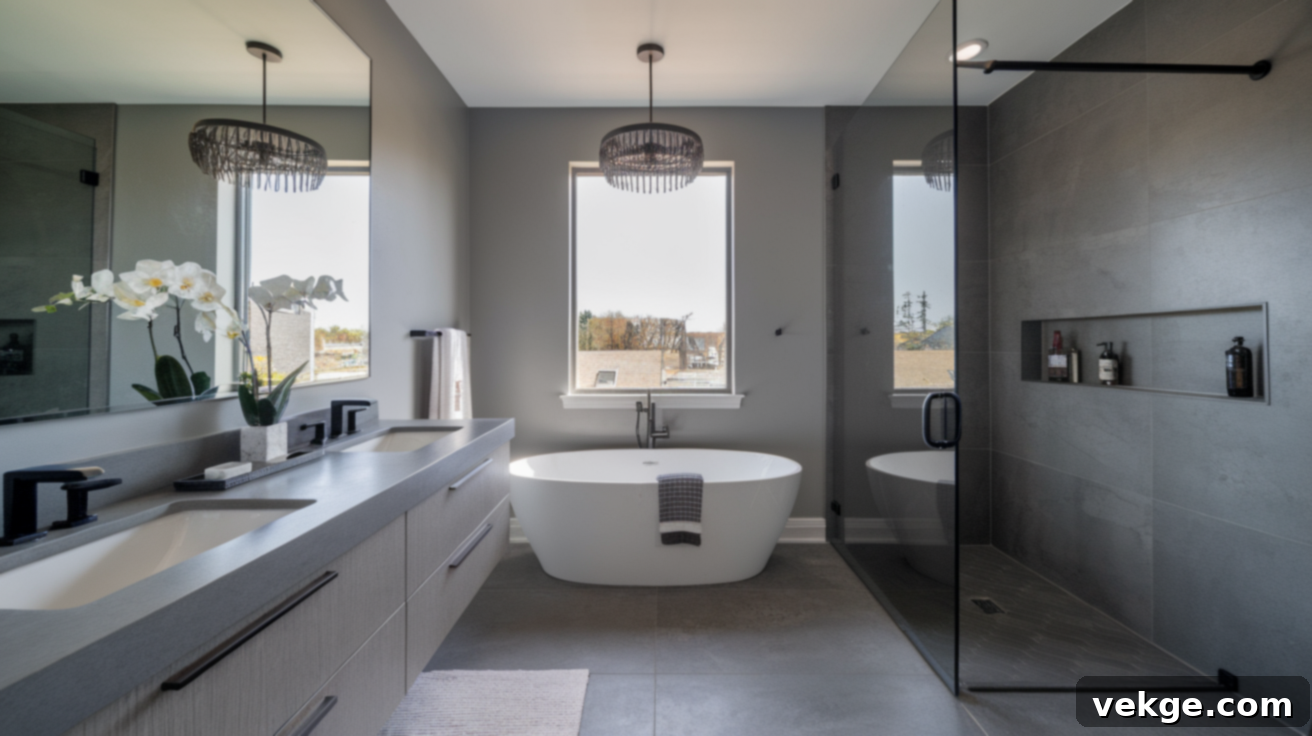
This style harnesses gray in its most cutting-edge and contemporary form, defined by clean lines, minimalist aesthetics, and a distinct lack of unnecessary fuss. Achieve this look by pairing light pearl gray walls with industrial-chic concrete-look floor tiles or polished concrete. Incorporate smoky gray glass shower doors for a subtle touch of sophistication. Introduce warmth and organic texture with wood-toned cabinetry that features subtle gray undertones, preventing the space from feeling too stark. Lighting is paramount in this design; use warm-toned LED bulbs in strategic fixtures to cast a welcoming glow, effectively preventing the space from feeling cold or uninviting and highlighting the subtle nuances of the gray palette.
8. Luxury Blue Monochromatic Bathroom: Deep Ocean Opulence
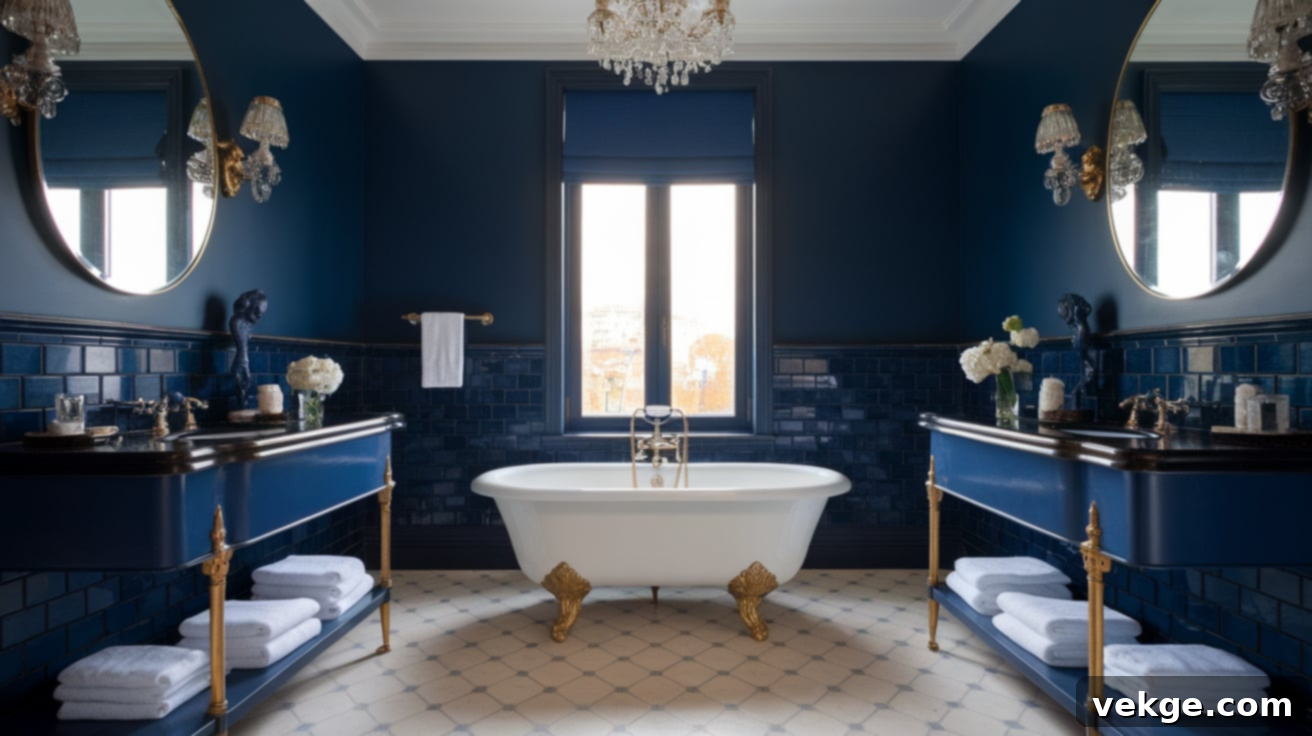
Cultivate an undeniably high-end, opulent feel with deep navy walls, perhaps in a sumptuous velvet-matte finish, and lustrous sapphire-toned tiles that catch the light. The choice of fixtures is crucial: add gleaming brass or warm gold hardware and faucets that pop elegantly against the rich blue background, introducing a touch of refined glamour. Elevate the comfort factor with plush navy towels and consider a patterned blue rug, perhaps with a subtle geometric or abstract design, for an additional layer of texture and visual interest. This rich and deeply saturated color palette pairs exquisitely with marble featuring delicate blue veining, creating a truly luxurious and immersive visual experience reminiscent of deep ocean tranquility.
9. Rustic Green Monochromatic Bathroom: Forest Retreat
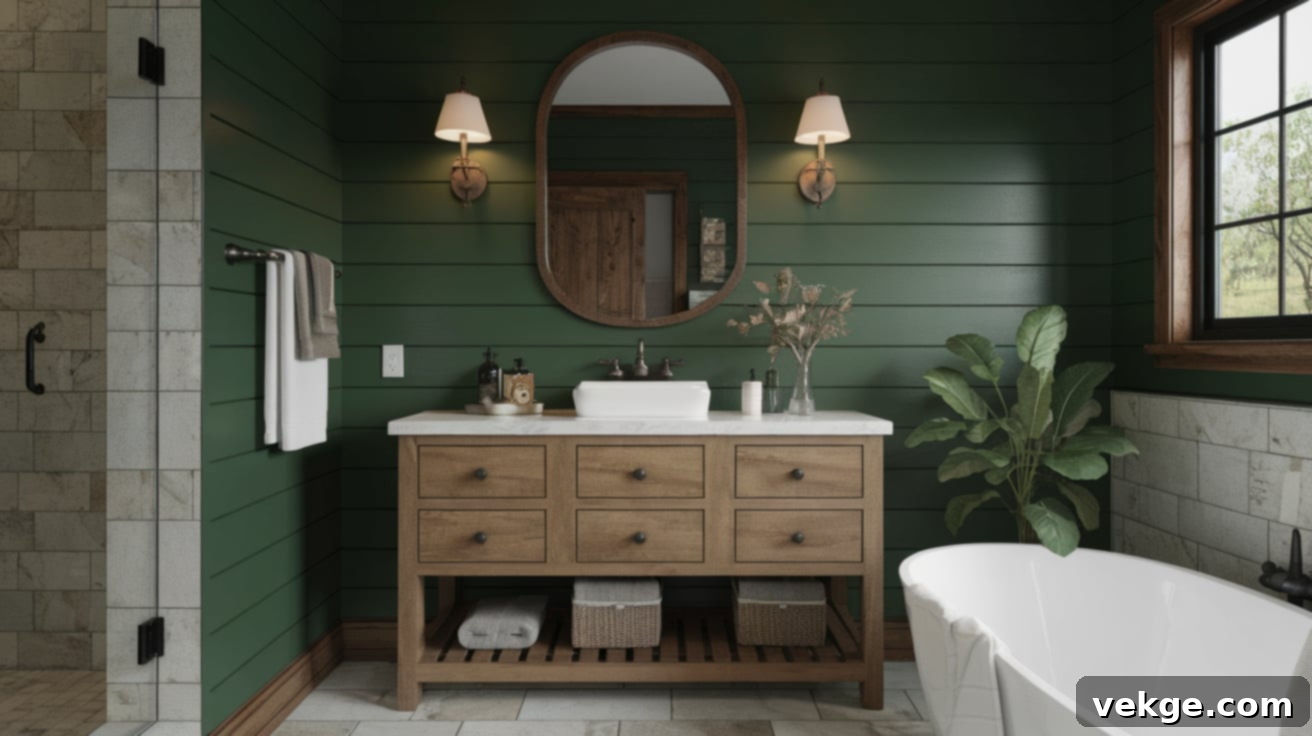
Bring the invigorating essence of the outdoors directly into your home with this nature-inspired green bathroom. Utilize rich forest green shiplap or beadboard for the walls, creating a charming textural backdrop. Complement this with darker emerald or olive green floor tiles, perhaps in a natural slate or ceramic finish. Introduce authentic wooden elements throughout the space, such as a rustic vanity crafted from reclaimed wood or a small stool in a warm, natural finish. Stone tiles in the shower area, with their varied textures and organic appeal, further enhance the rustic, earthy feel. Abundant live plants in various shades of green are the perfect finishing touch, completing the harmonious connection to the natural world.
10. Chic Black Monochromatic Bathroom: Urban Sophistication
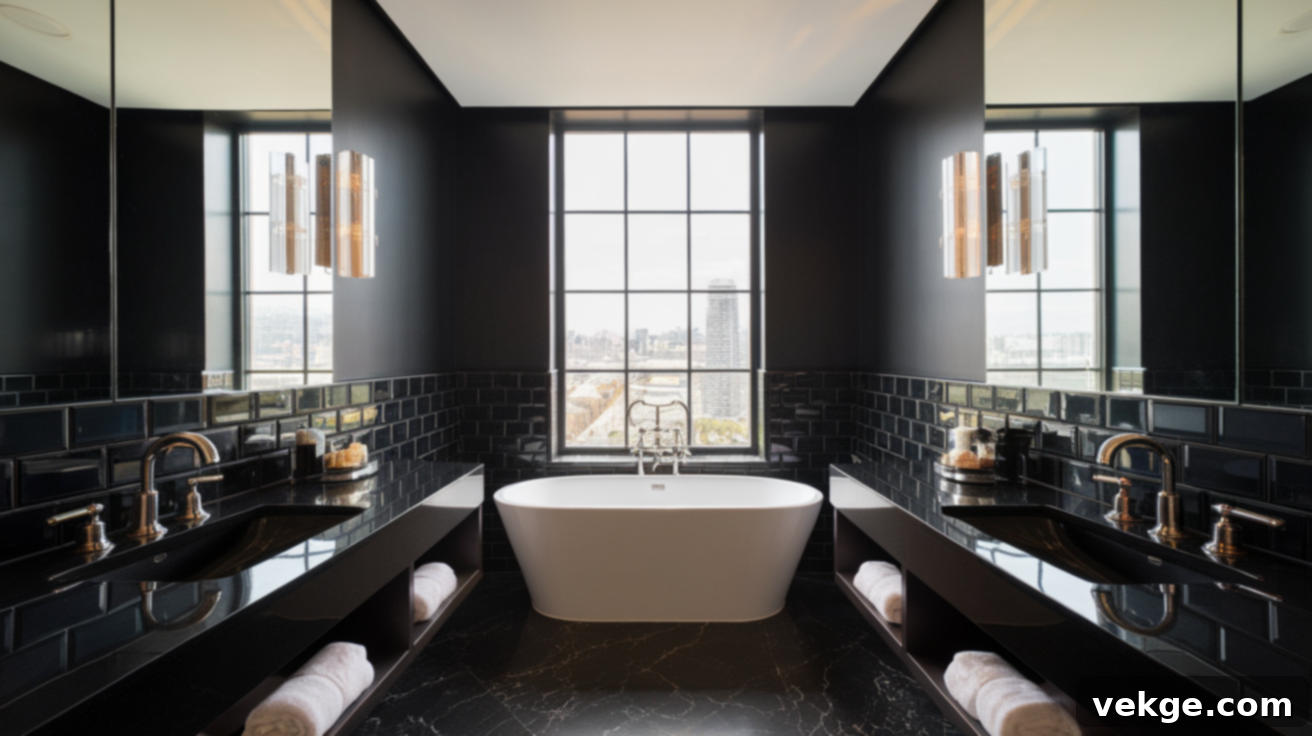
This contemporary interpretation of a black monochromatic bathroom masterfully blends various finishes to achieve a remarkably fashionable and sophisticated look. Combine deep matte black walls with subtly glossier black tiles, perhaps large format porcelain or sleek subway tiles, and pair them with refined black fixtures for textural harmony. Crucially, break up the intensity of the darkness with an abundance of strategically placed mirrors and transparent glass elements, such as a frameless shower enclosure. The key to success here is balance: while black forms your dominant color, ensure there are sufficient light sources, both natural and artificial, to prevent the space from feeling overly enclosed or heavy, maintaining an open and inviting ambiance.
11. Warm White Monochromatic Bathroom: Cozy Serenity

In contrast to the crisp, bright appeal of pure white, this inviting bathroom design exclusively employs a palette of warm whites and creamy off-whites to cultivate a profoundly cozy and welcoming atmosphere. Combine soft off-white walls with luxurious cream-colored floor tiles, perhaps in a large format for seamlessness, and bone-colored fixtures that exude understated elegance. Integrate natural wood elements, such as a light oak vanity or a small wooden bench, and introduce woven textures through baskets, rugs, or linen towels to amplify the warm, organic ambiance. This softer, more nuanced take on white successfully creates a wonderfully snug and inviting space that feels anything but clinical or stark, enveloping you in comfort.
12. Soft Blue Monochromatic Bathroom: Dreamy Cloudscape
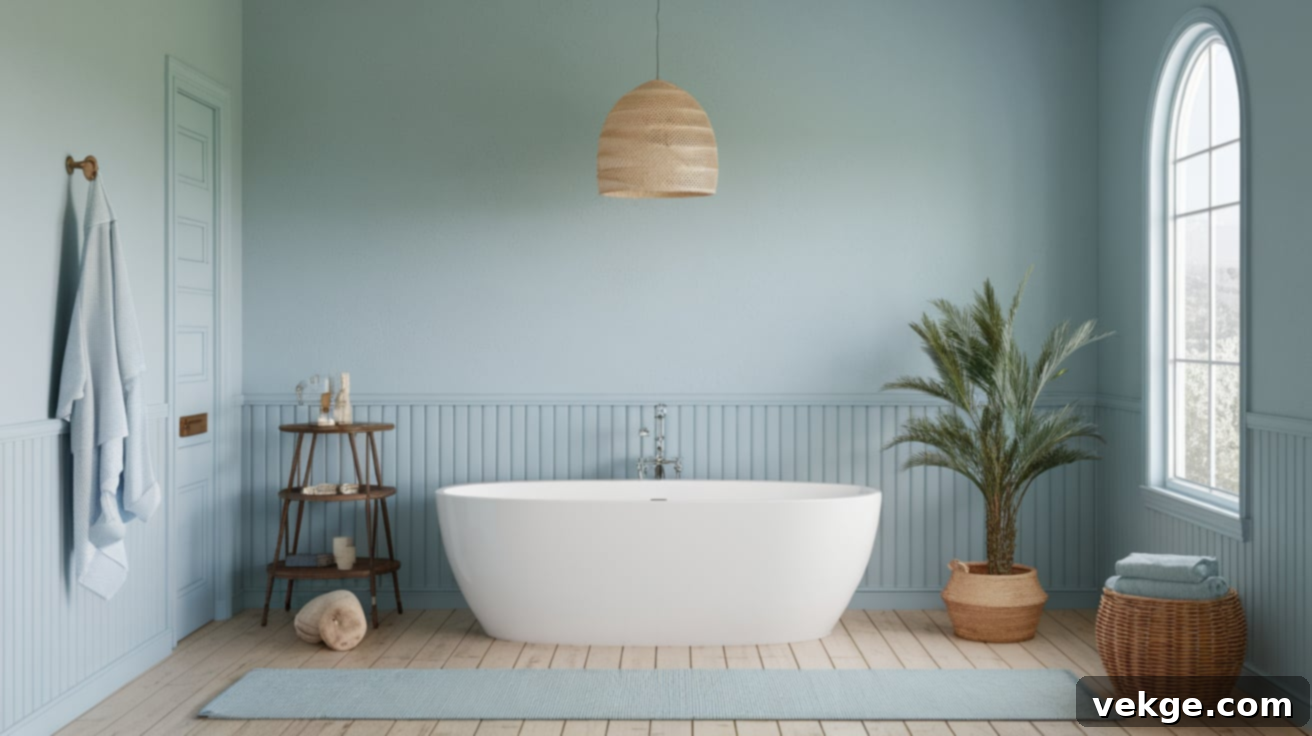
This gentle and ethereal approach to blue crafts a dreamy, cloud-like ambiance within the bathroom, perfect for unwinding. Utilize the palest, almost translucent, blues for the walls, evoking a sense of boundless sky. Introduce slightly deeper sky blue tones for tiles, perhaps in a mosaic pattern, or within the shower areas, creating subtle pockets of color. Integrate soft blue textiles, such as fluffy towels or a sheer shower curtain, in various textures like waffle weave or ribbed patterns for delicate visual interest. This serene color scheme harmonizes beautifully with classic white fixtures and shimmering silver or chrome accents, collectively producing an irresistibly light, airy, and truly tranquil bathroom retreat.
13. Minimalist Monochromatic Bathroom: Simplicity Defined
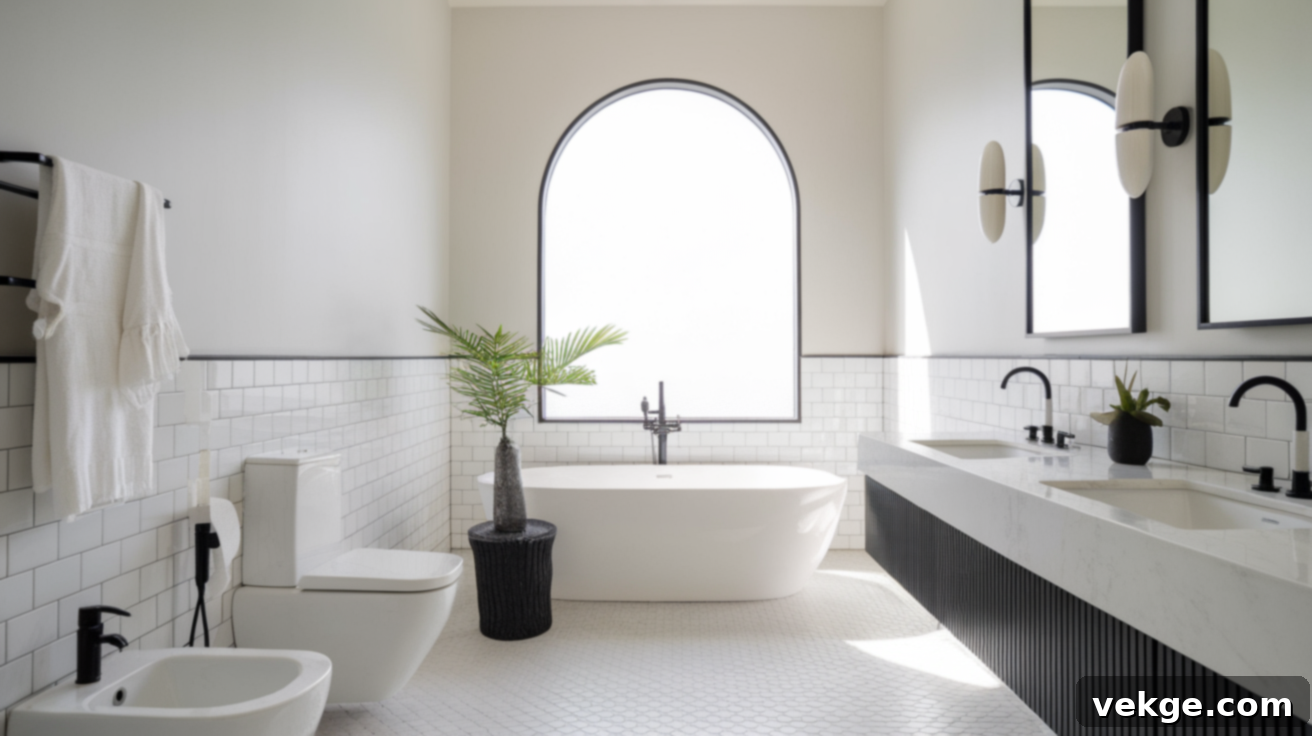
A minimalist monochromatic bathroom design is characterized by its rigorous stripping away of excess, focusing instead on the pristine beauty of clean lines, essential forms, and understated elegance. Choose one core shade as your base—be it white, gray, or black—and meticulously apply it with unwavering consistency throughout the entire space. Keep all fixtures inherently simple, opting for sleek, unadorned designs, and ensure hardware is minimal, perhaps integrated or push-to-open. Consciously avoid busy patterns, ornate decorations, or an abundance of accessories. Instead, allow subtle variations in texture, the purity of the lines, and thoughtfully designed lighting to be the sole creators of visual interest, fostering a profoundly serene and uncluttered environment.
Tips for Making Your Monochromatic Bathroom Feel Dynamic
Even with a meticulously chosen single-color scheme, your bathroom doesn’t have to succumb to flatness or boredom. The true artistry lies in ingeniously creating depth, contrast, and compelling visual interest exclusively within your chosen color palette. This requires a nuanced understanding of how different elements interact.
Adding Contrast and Accent Pieces Strategically
While steadfastly maintaining consistency in your main color, strategically incorporate small, impactful touches that introduce vital contrast and visual breaks. Consider the sophisticated sparkle that metallic hardware can add; brushed nickel offers a soft, diffused gleam, polished chrome provides a crisp, modern reflection, and warm brass or gold can introduce a touch of vintage luxury, all without disrupting your core color scheme. Small wooden elements, such as a meticulously crafted stool, a floating shelf, or even a picture frame, bring essential warmth and natural texture to the space. In lighter monochromatic bathrooms, black-framed mirrors or sleek black shower doors can provide striking definition and a contemporary edge. Conversely, in darker monochromatic settings, white trim or light-colored artwork can create welcome visual relief. Additionally, introducing live plants infuses the space with natural life, vibrant organic texture, and a refreshing burst of green that harmonizes beautifully with most color schemes, enhancing the overall atmosphere. The overarching objective is to skillfully uphold your single-color narrative while thoughtfully adding just enough variation to continuously engage the eye and prevent any sense of monotony.
Leveraging Lighting Choices for Mood and Depth
Lighting is an extraordinarily powerful tool in defining how your monochromatic bathroom looks and, more importantly, how it feels. A well-designed lighting scheme is paramount. Strive for a harmonious blend of natural light, if available, and artificial lighting to achieve a balanced and versatile illumination throughout the day and night. Employ lights at varying heights—think overhead recessed lighting, elegant wall sconces at eye level, and even subtle toe-kick lighting—to create intriguing shadows and strategically highlight different textures and architectural features. Installing dimmer switches is highly recommended, allowing you to effortlessly adjust the mood from bright and energizing for morning routines to soft and profoundly relaxing for an evening soak. In bathrooms featuring cooler color palettes (like blues or grays), using warm-toned bulbs can introduce a comforting glow and prevent the space from feeling too stark or cold. Ultimately, expertly planned lighting not only illuminates but also reveals the subtle, intricate variations within your color palette and accentuates the delightful textural differences between materials, thus transforming a potentially flat, one-note bathroom into a rich, layered, and deeply inviting sanctuary.
Common Mistakes to Avoid in Monochromatic Bathroom Design
Creating a truly exceptional monochromatic bathroom, while seemingly straightforward in concept—simply using one color—can be surprisingly challenging. Several common pitfalls can inadvertently lead to a bathroom that feels flat, uninspired, or even overwhelming, rather than the intended stylish and cohesive retreat. Being aware of these missteps is the first step towards a flawlessly executed design.
Here are the most common mistakes to diligently watch out for when designing your single-color bathroom, along with insights on how to sidestep them:
- Using Only One Shade: This is perhaps the most frequent error. Relying exclusively on a single shade of your chosen color, rather than masterfully mixing light, medium, and dark versions, will inevitably result in a flat, one-dimensional appearance that lacks depth and visual interest.
- Neglecting Textural Variety: Failing to incorporate a diverse range of different textures—such as glossy, matte, smooth, rough, soft, and hard materials—will leave your space feeling stark and uninviting, depriving it of crucial tactile and visual richness.
- Poor Lighting Design: Overlooking the critical role of proper and varied lighting will diminish the impact of your design. Inadequate lighting can make subtle color variations indistinguishable and textures appear flat, preventing the space from truly shining.
- Over-saturation with the Same Color: Going to an extreme by trying to make absolutely every single item in the bathroom the exact same color often creates a forced, artificial, and even suffocating environment rather than an elegant one.
- Missing Opportunities for Subtle Contrast: Being too rigid about a “pure” monochromatic scheme and not allowing for small, strategic contrasting elements (like metallic hardware, wood accents, or a single plant) can rob the space of vital visual breaks and personality.
- Choosing the Wrong Core Color: Selecting a color that doesn’t align with your bathroom’s size or natural lighting conditions can have disastrous results. A dark color in a windowless bathroom, for instance, will feel oppressive.
- Excessive or Competing Patterns: While subtle patterns in the same color can work, introducing too many patterns or patterns that are too busy and compete for attention within your already limited color scheme will create visual chaos.
- Ignoring Practical Needs: Prioritizing the maintenance of the color scheme over practical functionality (e.g., choosing a beautiful but impractical finish for a high-traffic area) can lead to frustration and a bathroom that doesn’t truly serve its purpose.
- Forgetting About White Space: Even in a monochromatic setting, the concept of “white space” (or “breathing room”) is crucial. Overfilling the space with too many items, even if they’re the right color, can make it feel cluttered rather than serene.
Conclusion: Embrace the Serenity of Monochromatic Design
Monochromatic bathrooms offer a truly timeless and sophisticated approach to interior design, masterfully striking a delicate balance between elegant simplicity and compelling visual interest. By committing to a single dominant color and ingeniously playing with its myriad shades, tones, and textures, you possess the power to transform a mere bathroom into a space that feels simultaneously unified, profoundly cohesive, and rich in intricate detail. This design philosophy champions a focused vision, allowing each element to contribute to a greater, harmonious whole.
Whether your heart desires the pristine, invigorating crispness of white, the grounding, modern allure of gray, or the confident, dramatic statement of black, a monochromatic palette provides an expansive canvas for personalized expression. The inherent beauty lies in its adaptability and its ability to reflect your unique style while maintaining an air of refined calm.
The secret to unlocking the full potential of this style is thoughtful and deliberate layering of tones, along with the strategic incorporation of diverse textures. These elements work in concert to create depth, prevent flatness, and ensure that your single-color sanctuary remains endlessly captivating. As you embark on planning your next bathroom update, consider the profound impact this focused and elegant design approach can have. Imagine how a monochromatic palette might just be the perfect key to unlocking the tranquil, stylish, and enduringly beautiful bathroom you’ve always dreamed of for your home.
